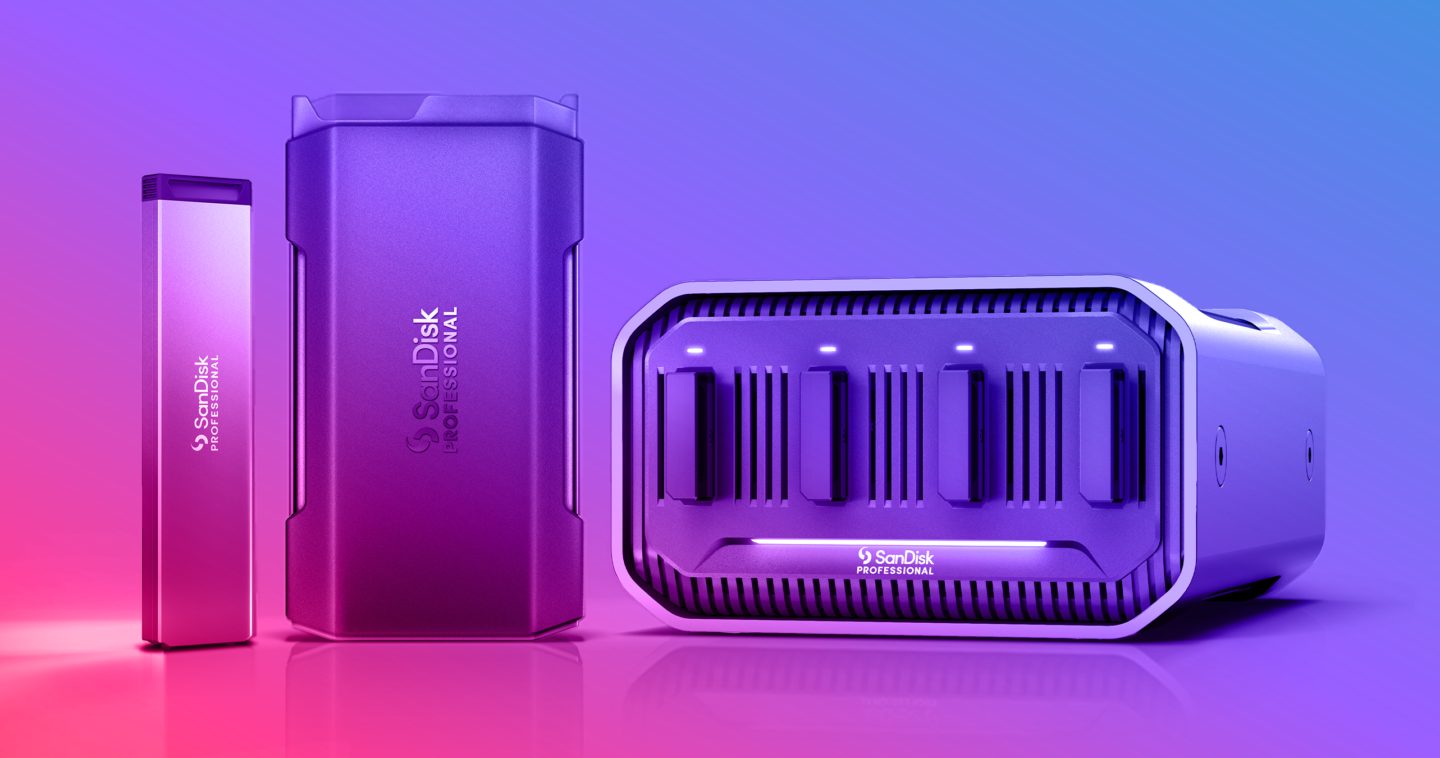Upon first look at the SanDisk Professional PRO-BLADE modular SSD ecosystem, Adorama asks their audience in a video titled, “Next Evolution of SSD?”
The ecosystem, unveiled at the “What’s Next Western Digital” event, comprises three products. The PRO-BLADE NVMe SSD Mag offers up to 4TB of storage and slides easily in and out of its enclosures, the portable PRO-BLADE Transport, which holds a single mag, or the desktop PRO-BLADE Desktop Station, which holds four.
Adorama viewers have mixed opinions. One calls PRO-BLADE a “brilliant system,” while another isn’t sure how this differs from the current market, “tbh.”
But what makes the SSD mags exciting is that they are not a proprietary technology. While the PRO-BLADE system at present isn’t so different from current market offerings, its proposition to the storage industry is dramatic: interchangeable, infinitely scalable storage.
Is this the next evolution of SSD? A brilliant system for the recent population surge of content creators? After years of researching creator needs, SanDisk Professional has developed a solution so innovative, it might just win over the cynics.
A brand (re)born
A few years ago, Western Digital noticed a change of tides. G-Technology, long a cult favorite of behind-the-scenes specialists in Hollywood entertainment, was spreading beyond the capitol of motion pictures. The market for professional-grade storage devices was beginning to explode.
But G-Tech faced challenges growing at scale. “There were certain countries and regions where G-Tech wasn’t established, or in some cases such as China, could not be established for trademark reasons,” said Christina Garza, director of flash product marketing. To meet this growing niche of content creators, a rebrand was in order.
This is how SanDisk Professional was born. After years of research, the flash marketing team decided to fold the G-Tech line under SanDisk, whose SD cards were already trusted by creatives around the world. G-Tech was no longer an industry secret, but a faithful subset of data center-quality storage products for professional creators.
However, impressing G-Tech’s following required more than new packaging. “Rebrands don’t always mean good things when it comes to product performance,” photographer and G-Tech devotee Jaron Schneider expressed in a SanDisk Professional review for PetaPixel. But G-Tech users, Schneider included, were happily surprised.
Under SanDisk Professional, G-Tech products received an upgrade. The SSDs increased in ruggedness and transfer speed, from 560 MB/s to a whopping 1050 MB/s. The G-RAID systems were outfitted with dual-mode technology to work with both Thunderbolt and USB interfaces. “Little tweaks like that make a significant difference to the end user,” Garza explained.
Additionally, SanDisk Professional launched unique products to inaugurate their catalogue. They unveiled the PRO-READER family, featuring best-in-class offload speeds, alongside SanDisk Extreme Pro UHS-I SD and microSD cards offering up to 200 MB/s read speeds – the fastest in the world.
SanDisk Professional delivers micro-sized versions of the same technology Western Digital develops for hyperscale data clients. In his presentation at “What’s Next Western Digital,” EVP and GM of the flash business, Rob Soderbery, identified SanDisk Professional’s market niche as “pro-sumers.”
“SanDisk Professional was born out of the insight that the needs of these professionals are diverging pretty dramatically from the average consumer need,” Soderbery continued. This insight has paid substantial dividends already. In just one year, SanDisk Professional has shipped 1.7 exabytes of storage. As the content creation sector continues to balloon, the brand’s specific attention to the needs of creative professionals grows more important.
Media captures the moment
Since 2020, creatorship has become the fastest-growing kind of small business. In 2021 alone, VCs invested over $2 billion in 50 creator-focused startups. Five years ago, the only social media platform that paid its channel owners was YouTube. Now, the creator market is estimated at $104 billion and growing. Vogue Business has dubbed our current era “the creator economy gold rush.”
Data storage technology is sprinting to meet this demand, with $2.2 billion in smart products forecasted to ship this year. As content creation proliferates, its processes demand more storage. It takes 15 minutes for a 12K camera to fill SanDisk Extreme Pro’s 512GB CFast 2.0 card, the largest-capacity, highest-performing card SanDisk offers. As creative workflows shift, data solutions must adapt to new requirements.
“We can’t overlook the importance of the media we capture to,” Michael Coleman said onstage at “What’s Next Western Digital.” Coleman is an award-winning director and cinematographer whose films explore the meaning and work behind sound, like his SoundWorks series documenting the audio teams behind blockbuster movies. He emphasizes data storage’s centrality to the creative process, especially when it goes unnoticed.
“The more data we collect upfront, the more opportunities we have down the line at each touchpoint.” Each project Coleman works on requires 300GB to several TBs of storage. Last year, he produced more than 100 projects. Onstage at “What’s Next Western Digital,” Soderbery asked Coleman about the stakes of losing data.
“It’s the worst nightmare,” he responded. “Your camera you can replace, but you can’t replace footage or a moment. You always try to think of redundancies in workflows. You can’t explain to your client why something that shouldn’t be a factor is playing such a big role,” Coleman said.
Coleman and SanDisk Professional share a poetic kinship. Coleman expresses the stories of sound-makers whose greatest accomplishments are often imperceptible to listeners. The greatest contribution data storage can make to the creative process is a similar behind-the-scenes act, the imperceptible facilitation of artistic workflow.
How does one engineer data storage to become a nonfactor in an increasingly complex, multi-faceted sector steadily populating with more users and diverse needs? There are a few obvious goalposts: higher capacity, greater speed, smaller devices. But mixing and matching technology to achieve various combinations of these factors has created its own issue for users: navigating a storage market where products are as disparate as their users, and often incompatible with one another.
Is there a silver bullet solution? Is one even possible? SanDisk Professional says – hold on to your hat.
Evolving the medium
Enclosed in the PRO-BLADE Transport, the PRO-BLADE SSD Mag is just a portable SSD.
The SSD mags are the core unit of the PRO-BLADE ecosystem. Though they carry up to 4TB and offer both 3-meter drop protection and 4,000-pound crush resistance, they are ultra-lightweight and portable, with aluminum cases measuring just over 4 inches by 1 inch.
But once enclosed in the PRO-BLADE Transport or Desktop Station, they function like any other SSD. The PRO-BLADE Transport enclosure holds one mag at a time, fit for any standard camera rig, while the PRO-BLADE Station holds four, enabling 40 Gb/s Thunderbolt interface speeds for immediate editing work. The mags slide in and out of these enclosures in seconds. “It’s not a scary system with a big learning curve to use,” said Christina Garza.
“It’s not groundbreaking in the sense that it works differently with your host devices. It’s groundbreaking in that, once you plug it in, all you have to do is interchange the storage.”
If you aren’t a professional videographer, it might be unclear what makes interchangeable storage so novel. If you are, you are intimately familiar with your extensive library of drives, whose supply and organization is possibly the bane of your existence. The prospect of streamlining this storage by universal standard might have you drooling at this very moment.
Perhaps more enticing is this storage standard is a fraction the weight and size of the same capacity SSDs on today’s market. Even further – that this standard is separate from the myriad enclosures shaped to optimize each one’s express purpose, so editors can tackle massive amounts of footage at the same speed it is captured, while videographers can slip a fresh 4TB SSD mag to their camera without ever touching the rig.
This is the radical suggestion of PRO-BLADE: that the professional-grade storage market divide data proper from its numerous use cases, so providers focus their efforts on enclosure technology rather than 3D NAND. While this would require a significant departure for storage brands, its potential benefits for consumers are undeniable.
The factors that providers combine endlessly in product after product have resulted in a storage market so confusing that shoppers often spend more time trawling online technology forums than store aisles. With PRO-BLADE’s proposed shift, some of these factors would disappear entirely, empowering companies to develop specialized data enclosures that can truly change the game.
And when it comes to data storage for creative professionals, changing the game means evolving the artistic medium. With 15 years on the job, Michael Coleman has watched filmmaking’s possibilities multiply with each addition to the technology. “When new technology gets introduced, it challenges us creatives and gives us more tools to work with,” he said.
“The exciting thing about today is that we have so many tools, you can run in any direction.” The PRO-BLADE line seeks to upgrade data storage so it can do what it does best: recede into the background of the creative process, becoming a tool so basic and fundamental it can be taken for granted, used as absentmindedly as a painter reaches for paper, or an athlete hits the pavement for a sprint.
At present, the PRO-BLADE ecosystem is just a top-of-the-line SSD. Simultaneously, it is introducing a future for data storage that can transform the playing field for content creators. SanDisk Professional is excited to see where they run.



